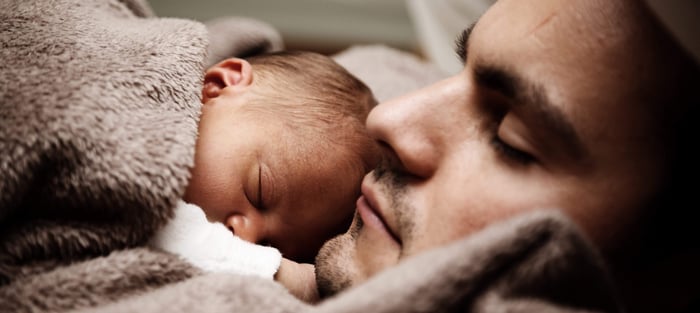What exactly is co-sleeping? Is it considered co-sleeping when your little one climbs into bed with you in the wee hours of the night? To some, co-sleeping just means sharing the room with their toddler or infant. In reality, it's both.

According to KidsHealth®, co-sleeping is when a parent and child sleep in close social and physical contact. There are two types of co-sleeping arrangements: bed-sharing and room-sharing.
Bed-sharing is when you and your child sleep in the same bed or on the same surface together. Room-sharing is when your child is sleeping in the same room with you but in a bassinet, portable crib or in a separate bed.
Both of these scenarios are technically considered co-sleeping, and the long-term impact can be either positive or negative depending on the circumstances and the particular emotional needs of the family involved.
Why Do Parents Choose Co-Sleeping?
Just like any other hotly debated topic, co-sleeping has its fair share of proponents and detractors. Advocates of co-sleeping often point to a long list of perceived benefits for both the child and parent. KidsHealth® stresses that co-sleeping by bed-sharing can encourage breastfeeding in the evening, assist with synchronized sleep schedules for nursing mothers, help babies fall asleep easier and promote closeness between baby and parent.
However, there are also certain risks associated with co-sleeping, and bed-sharing in particular, that often cause parents to choose a room-share arrangement instead.
What are the Risks of Co-Sleeping?

Not all bed-sharing arrangements are the same, so any risk factors are largely determined by which arrangement you choose. The most common concern in regard to bed-sharing is the possibility of sudden infant death syndrome (SIDS). However, NPR reported on several recent studies that seem to indicate the risk for SIDS is tied more to the child's overall risk for SIDS and not simply they're presence in the bed with their parents.
If your baby's overall chances of SIDS are low, meaning you're not sleeping on the couch and you're not drinking alcohol or smoking before bed, then the risk of SIDS from bed-sharing are relatively low. Parents who smoke, drink to excess, take drugs, are extremely tired or who place the baby between two adults greatly increase the risk factors for suffocation, entrapment and strangulation. When you remove these factors, the data shows that bed-sharing is exponentially safer.
Why do children seem inherently drawn to co-sleeping in the first place? It's because babies are contact seekers and, though the topic seems new, the practice of co-sleeping has been practiced since homo sapiens first appeared more than 200,000 years ago. James McKenna, an anthropologist at Notre Dame, told NPR that co-sleeping has evolutionary ties to a child's physiology and their survival instinct to be close to their parents' bodies.
Safe Co-Sleeping Practices
Obviously, if you plan to co-sleep with your baby, you're going to want to do it as safely as possible. Placing a bassinet or crib next to your bed is typically ideal for those under 4 months old. If you're bed-sharing, make sure to place your baby on his or her back to reduce the risk of SIDS. Also, keep the child's clothing light and minimal to reduce overheating, and never leave them alone in the adult bed.
The American Academy of Pediatrics recommends the following best practices to create a safe sleep environment:
- Place the baby on his or her back on a firm sleep surface such as a crib or bassinet with a tight-fitting sheet.
- Avoid the use of soft bedding, including crib bumpers, blankets, pillows and soft toys. The crib should be bare.
- Share a bedroom with parents, but not the same sleeping surface, preferably until the baby turns 1 but at least for the first six months. Room-sharing decreases the risk of SIDS by as much as 50%.
- Avoid baby's exposure to smoke, alcohol and illicit drugs.
When It's Time To Sleep Alone
As your baby develops their fine motor skills, their sleeping habits will also change. This can make it an easier transition when it's time to close the book on co-sleeping. Once you begin the process, it's healthy to set boundaries. It's important not to go back to your old ways so that your child understands there is a time and place for sleep.
When you're ending co-sleeping with a newborn to an 18-month-old, Today's Parent recommends that your baby's new bed isn't filled with bumpers and blankets. They also recommend that you should sleep with your baby's new sheets first so that familiar scent is present in their new bed.
Other techniques that may ease the transition are using a noise machine, sleep training and working with a sleep consultant. It's important to remember that this is a process and taking your time and being consistent means a more successful switch.
When you're going through this changeover with your toddler, using communication is more effective. Because they've most likely been doing this for a few years, changing up their routine might be a shock to them at first. Use communication to explain the importance of sleep and sleeping alone for a few months before you decide to cut ties altogether. This will prepare them for the journey ahead.
Getting your kiddo excited for a new "big kid" room by decorating their space how they like or letting them pick out their new sheet colors is another great way to ease them into nights without you by their side. It's important to create a consistent routine, being mindful that they still might need you around bedtime, and that's OK. Spend quality time with them before bed so they are assured you're not far away.
Don't be abrupt when it comes to getting your child to sleep alone at night. They will be confused which could lead to a lot of tears and them showing up in your room in the middle of the night. When that happens, console them and walk them back to bed. Stay with them for a little bit before retreating back to your own room. Doing this will make for a well-rested and happier child -- and parent -- later on.
There are different views when it comes to the topic of co-sleeping. However, at the end of the day, bed-sharing and room-sharing aren't always avoidable. If you're someone who co-sleeps with your infant, know that 60% of mothers admit to sharing the bed with their baby at some point in the night. This is all to say that you're not alone.
Co-sleeping is entirely up to you and what you're comfortable with. Whether you're a new mom or you're in the process of transitioning into new sleep habits with your toddler, it's always best to use safe practices. Once you've made it back into your bed alone, treat yourself to a new sheet set from SHEEX. You deserve it, and that's something we can all agree on. Maybe your little ones crawl into bed with you because they love the coziness of your bed. Here is one Dad's solution:
Original Performance Sheet ★★★★★
"Of all the sheets that I or my wife have ever bought these are by far the most comfortable breathable sheet, We have Egyptian cotton thousand thread count from some of the department stores and did not find them as comfortable as these we now have two sheets sets for your children and they are very happy and comfortable and then we can keep them out of our bed."






